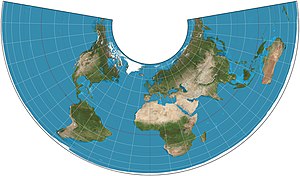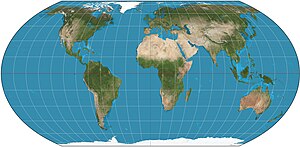Equal-area projection
 From Wikipedia the free encyclopedia
From Wikipedia the free encyclopedia

In cartography, an equivalent, authalic, or equal-area projection is a map projection that preserves relative area measure between any and all map regions. Equivalent projections are widely used for thematic maps showing scenario distribution such as population, farmland distribution, forested areas, and so forth, because an equal-area map does not change apparent density of the phenomenon being mapped.
By Gauss's Theorema Egregium, an equal-area projection cannot be conformal. This implies that an equal-area projection inevitably distorts shapes. Even though a point or points or a path or paths on a map might have no distortion, the greater the area of the region being mapped, the greater and more obvious the distortion of shapes inevitably becomes.

Description
[edit]In order for a map projection of the sphere to be equal-area, its generating formulae must meet this Cauchy-Riemann-like condition:[1]
where is constant throughout the map. Here, represents latitude; represents longitude; and and are the projected (planar) coordinates for a given coordinate pair.
For example, the sinusoidal projection is a very simple equal-area projection. Its generating formulae are:
where is the radius of the globe. Computing the partial derivatives,
and so
with taking the value of the constant .
For an equal-area map of the ellipsoid, the corresponding differential condition that must be met is:[1]
where is the eccentricity of the ellipsoid of revolution.
Statistical grid
[edit]This section needs expansion. You can help by adding to it. (April 2020) |
The term "statistical grid" refers to a discrete grid (global or local) of an equal-area surface representation, used for data visualization, geocode and statistical spatial analysis.[2][3][4][5][6]
List of equal-area projections
[edit]These are some projections that preserve area:
- Azimuthal
- Lambert azimuthal equal-area
- Wiechel (pseudoazimuthal)



- Cylindrical (with latitude of no distortion)
- Lambert cylindrical equal-area (0°)
- Behrmann (30°)
- Hobo–Dyer (37°30′)
- Gall–Peters (45°)

- Pseudocylindrical
- Other
- Eckert-Greifendorff
- McBryde-Thomas Flat-Polar Quartic Projection[7]
- Hammer
- Strebe 1995
- Snyder equal-area projection, used for geodesic grids.
See also
[edit]- Authalic latitude
- Authalic radius
- Equiareal map (mathematics)
- Measure-preserving dynamical system
- Geodesic polygon area
References
[edit]- ^ a b Snyder, John P. (1987). Map projections — A working manual. USGS Professional Paper. Vol. 1395. Washington: United States Government Printing Office. p. 28. doi:10.3133/pp1395.
- ^ "INSPIRE helpdesk | INSPIRE". Archived from the original on 22 January 2021. Retrieved 1 December 2019.
- ^ http://scorus.org/wp-content/uploads/2012/10/2010JurmalaP4.5.pdf [dead link]
- ^ IBGE (2016), "Grade Estatística". Arquivo
grade_estatistica.pdfem FTP ou HTTP, Censo 2010 Archived 2 December 2019 at the Wayback Machine - ^ Tsoulos, Lysandros (2003). "An Equal Area Projection for Statistical Mapping in the EU". In Annoni, Alessandro; Luzet, Claude; Gubler, Erich (eds.). Map projections for Europe. Joint Research Centre, European Commission. pp. 50–55.
- ^ Brodzik, Mary J.; Billingsley, Brendan; Haran, Terry; Raup, Bruce; Savoie, Matthew H. (13 March 2012). "EASE-Grid 2.0: Incremental but Significant Improvements for Earth-Gridded Data Sets". ISPRS International Journal of Geo-Information. 1 (1). MDPI AG: 32–45. doi:10.3390/ijgi1010032. ISSN 2220-9964.
- ^ "McBryde-Thomas Flat-Polar Quartic Projection - MATLAB". www.mathworks.com. Retrieved 3 January 2024.













